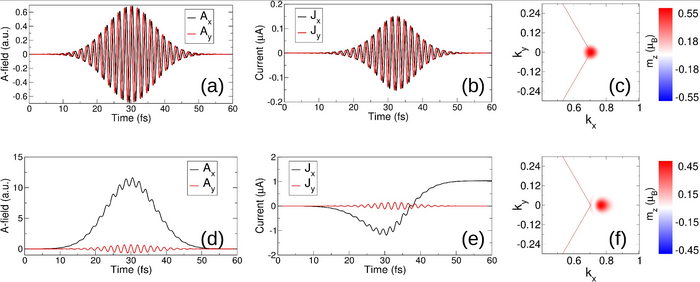Ultrafast laser control over the fundamental quantum degrees of freedom of matter represents the outstanding foundational challenge to be met in establishing future information technologies beyond the semi-conductor electronics that defines our present time. Two of the most promising quantum degrees of freedom in this respect are the spin of the electron and the “valley index”, the latter an emergent degree of freedom of two dimensional materials related to the quasiparticle momentum. Both spintronics and valleytronics offer many potential advantages over classical electronics in terms of data manipulation velocity and energy efficiency. However, while spin excitations suffer from a dynamical loss of character arising from the spin-orbit induced spin precession, the valley wavefunction represents a “data bit” whose stability is threatened only by intervalley scattering, a feature controllable be sample quality. Valleytronics thus presents a potentially robust platform for going beyond classical electronics.

Credit: The image may only be used with approriate caption and credit
Ultrafast laser control over the fundamental quantum degrees of freedom of matter represents the outstanding foundational challenge to be met in establishing future information technologies beyond the semi-conductor electronics that defines our present time. Two of the most promising quantum degrees of freedom in this respect are the spin of the electron and the “valley index”, the latter an emergent degree of freedom of two dimensional materials related to the quasiparticle momentum. Both spintronics and valleytronics offer many potential advantages over classical electronics in terms of data manipulation velocity and energy efficiency. However, while spin excitations suffer from a dynamical loss of character arising from the spin-orbit induced spin precession, the valley wavefunction represents a “data bit” whose stability is threatened only by intervalley scattering, a feature controllable be sample quality. Valleytronics thus presents a potentially robust platform for going beyond classical electronics.
At the heart of any future valleytronics or spintronics technologies will, in addition to quantum excitations encoding data bits, reside the control and creation of valley- and spin-currents. However, while sustained attention has been paid to the task of tailoring lightforms on ultrafast time scales to selectively excite valley quasiparticles, the precise creation and control of valley-currents and spin-currents – vital for any future valleytronics technology – has remained beyond the realm of ultrafast light control. In a study recently published in Science Advances, a team of researchers from the Max Born Institute in Berlin have shown how a hybrid laser pulse combining two polarization types allows complete control over ultrafast laser-light-induced currents.
Control over the charge state by circularly polarized light is now well established, the famous “spin-valley locking” of the transition metal dichalcogenides that has its origin in the valley selective response to circularly polarized light. This can be viewed as arising from a selection rule involving the magnetic quantum numbers of the d-orbitals that comprise the gap edge states. While circularly polarized light excites valley charge it does not, however, create a valley current as shown in Fig. 1a,b. This situation arises as for each quasi-momentum in the valley
Control over the charge state by circularly polarized light is now well established, the famous “spin-valley locking” of the transition metal dichalcogenides that has its origin in the valley selective response to circularly polarized light. This can be viewed as arising from a selection rule involving the magnetic quantum numbers of the d-orbitals that comprise the gap edge states. While circularly polarized light excites valley charge it does not, however, create a valley current as shown in Fig. 1a,b. This situation arises as for each quasi-momentum in the valley kvalley that is excited a corresponding –kvalley also is excited: the Bloch velocities thus cancel and there is no net valley current.
Full control over light induced valley currents, their magnitude and direction, thus requires going beyond the spin-valley locking paradigm of circularly polarized light. Creation of a valley excited state that does result in a net valley and spin current must therefore involving breaking the local kvalley , -kvalley degeneracy. As the laser vector potential couples directly to crystal quasi-momentum, k ->k – A (t)/c, the most effective way in which this can be done is through a linearly polarized single cycle pulse with duration comparable to that of the circularly polarized pulse: such a pulse will evidently be in the “THz window” of 1 THz to 50 THz. As shown in Fig. 1d,e the hencomb lightform generates a substantial residual (i.e. persisting after the laser pulse) current. This results from a non-cancellation of the Bloch velocities of excited quasi-momentum, as the distribution of excited charge is now shifted off the high symmetry K point by exactly the polarization vector of the THz pulse, as shown in Fig. 1f.
Journal
Science Advances
DOI
10.1126/sciadv.adf3673
Method of Research
Experimental study
Subject of Research
Not applicable
Article Title
THz induced giant spin and valley currents
Article Publication Date
15-Mar-2023
COI Statement
We declare that none of the authors have competing financial or non-financial interests.




